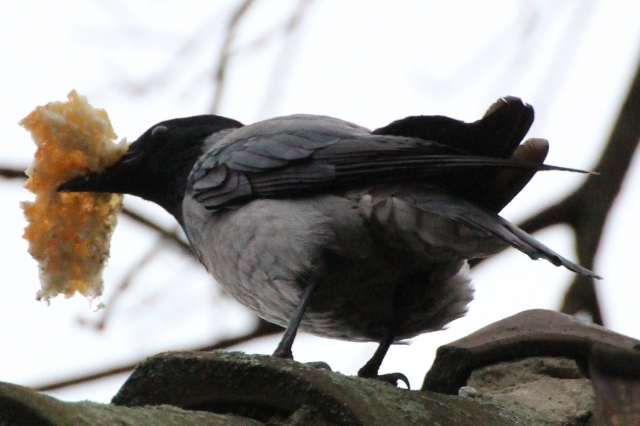I photographed this Hooded crow (Corvus cornix) on December 31, in the Berlin Zoo. There were huge numbers of crows assembled; they and Grey herons (Ardea cinerea) are apparently the birds best adapted to making use of the safe haven and plentiful food supply a zoo offers.
(did I mention that I love my new Canon EOS 650D with the Tamron 70-300 mm lens? Yes I sure did!)
Regular readers may know about my fascination with corvids (see here, here, here, here, here, here and (rook prOn!) here). As mentioned, many crows live permanently in the zoo, and on winter evenings their gathering in their sleeping trees is quite a spectacle.
OK, on to the herons now….
Because of their way of hunting, herons have an uncanny knack for setting themselves up for portrait photos. They stand still for eternities in exposed places, and there is ample time to find the ideal spot to take a picture from. Perches include the roof of the hippo house of the Berlin Zoo.
note the shapes of the toes – one is curving outward like crazy. Likely a pathology, and ichnologists do not really like these. Individual footprints are very hard to correlate with skeletons if either of the two is from a pathological individual.
(photographed one rainy day)
There’s a fun story about how utterly brutal and ruthless – and totally blasé about risk to themselves – heron are when fish is concerned. In the Stuttgart zoo there is a large aviary, the big covering net of which has a thick cable running along its rim between the poles that support it. Right next to it there is a footpath, and on the other side of it there is a Humboldt penguin enclosure. Sure enough, just before penguin feeding time herons come in from all over and sit on that cable. Once there is fish in the water, they dive in – from above and behind the people watching the penguins get fed. Quite a few people have gotten a Gibbs-slap by heron wings – and more than once have a seen a heron misjudge the distance and crash badly into people or the low penguin enclosure barrier.
Herons are usually rather free of fear, even of humans, and I have seen them take bait from a fishermen’s pail, or snatch them from just in front of a Sea Lion’s snout. Both are rather risky behaviours, whereas stealing them out of a pelican’s throat pouch is more of a risk to the pelican, I guess. That’s also something I have seen more often done by cormorants than by herons. Herons are, though, unquestionably happily involved in any kinds of water-related theropod feeding frenzy.
In winter, both crows and especially heron are even less shy then the rest of the year.

right on one of the main paths of the zoo – and there were two more herons standing right behind me. In fact, they walked up to children and scared them away!

Can you say “sitting duck”? If one of the California Sea Lions had been interested in a bit of theropod meat that day…..







Great pics. The Heron is the one bird in Northern Europe that I think you can capture the imagination with to a child and say “that’s a dinosaur” to them.